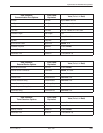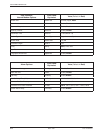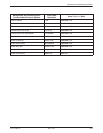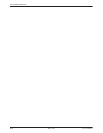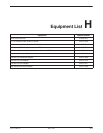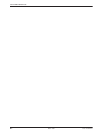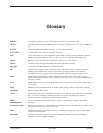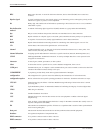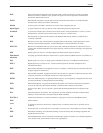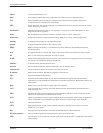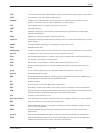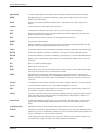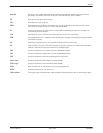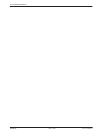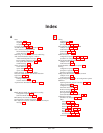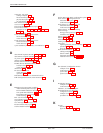
Glossary
Glossary-33163-A2-GB20-10 March 1999
Data Communications Equipment. The equipment that provides the functions required to establish,
maintain, and end a connection. It also provides the signal conversion required for communication
between the DTE and the network.
Data Channel Loopback. Loops the data received from the network interface, for all DS0 channels
allocated to the selected port, back to the network.
A factory-preset value that is assumed to be correct unless changed by the user.
A signal composed of only two discrete values, representing the binary digits 0 and 1.
A process that transfers device firmware and software from a locally-attached PC to a device, or allows
the duplication of firmware and software from a local device to a remote device.
Data Set Ready. A signal from the modem to the DTE that indicates the modem is turned ON and
connected to the DTE.
Data Service Unit. Data communications equipment that provides timing, signal regeneration, and an
interface to data terminal equipment. A subrate DSU/CSU is normally referred to as a DSU.
Data Service Unit/Channel Service Unit. A device that combines the functions of a DSU and a CSU. It
connects Data Terminal Equipment to the digital network, protects the line from damage, and regenerates
the signal.
Digital signal level 0 (zero). A 64 kbps digital telecommunications signal or channel.
Assigning specific DS0 channels in the E1 NTU to specific interfaces (HDSL Network, G.703 DTE, etc.).
Digital signal level 1 (one). A digital signal transmitted at the rate of 1.544 Mbps in North America.
Digital Signal Cross Connect level 1. An interconnection point for terminals, multiplexers and
transmission facilities.
Data Terminal Equipment. The equipment, such as a computer or terminal, that provides data in the form
of digital signals for transmission.
Data Terminal Loopback. Loopback mode that loops the data for a particular synchronous data port back
to the port just before it is combined with the rest of the T1 data stream.
Dual-Tone Multi-Frequency. A signaling method using two voice frequencies to designate the tones used
for touch-tone dialing, as distinguished from pulse dialing.
Data Terminal Ready. A signal from the DTE to the modem, sent via Pin 20 of the EIA-232 interface
(V.24 circuit 108/1, /2), that indicates the DTE is turned ON and connected to the modem.
Excessive Error Rate. An error rate that is greater than the threshold that has been configured in the
device.
Electronic Industries Association. This organization provides standards for the data communications
industry to ensure uniformity of interface between DTEs and DCEs.
An Electronic Industries Association standard for a high-speed, 25-position, DCE/DTE interface.
End of Number.
A discrepancy between a measured or computed value or condition and the true or specified value or
condition.
Errored Seconds. A second with one or more ESF error events (one or more CRC6 error events or OOFs).
ElectroStatic Discharge. An undesirable discharge of static electricity that can damage equipment and
degrade electrical circuitry.
Extended SuperFrame. The T1 transmission standard that specifies 24 frames as an extended superframe
to be used for frame synchronization and to locate signaling bits.
DCE
DCLB
default
digital signal
download
DSR
DSU
DSU/CSU
DS0
DS0 channel
allocation
DS1
DSX-1
DTE
DTLB
DTMF
DTR
EER
EIA
EIA-530-A
EON
error
ES
ESD
ESF



